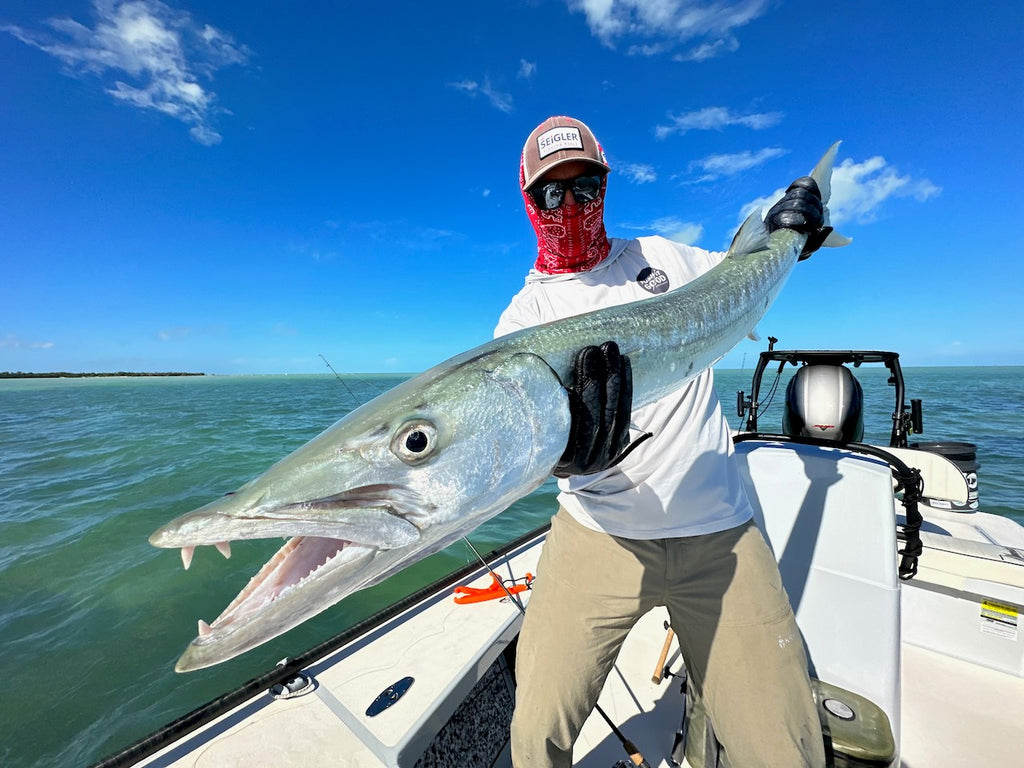New Year, New Inshore Angling Opportunities
Part Two
January 12, 2023

Captain Scott Brown on Lower Florida Keys bonefish, barracuda and more
PARK FALLS, Wis. (January 9, 2023) – A new year means new opportunities on the water – chances to target your favorite inshore species while also learning what’s necessary to grow as an angler, pursue new passions and earn new successes on the water.
Owner at Push it Good Inshore Charters, Captain Scott Brown guides anglers part time in the lower Florida Keys, which allows him to balance his passion for fishing with his love of family and service to our country. Active-duty Special Forces, Brown is also founder of Valliant Traditions, a non-profit with the primary mission of facilitating high-quality guided hunting and fishing experiences for active-duty soldiers, wounded warriors and Gold-Star families.
Bonefish – along with permit and tarpon – form the foundation of Brown’s flats-fishing enterprise, but other species, including barracuda, factor in throughout the year. Whether fishing with a guide or striking out on your own, his knowledge and insights will heighten your inshore game.
Brown on Bonefish

“A lot of anglers don’t realize the variation the Florida Keys see in terms of weather and water temperatures from one end to the other,” Brown says. “Things are very different here than they can be in the Northern Keys or even Marathon. We can have year-‘round fishing for bonefish on the flats here in the Lower Keys as long as water temperatures stay above 74 degrees or so. We can get big warm streaks in the dead of winter, and the bonefish will be there. It’s all dependent on those water temps.”
Brown says speed and accuracy in casting are the keys to the game whenever bonefish are on the flats. “An angler needs to be able to execute on the three D’s – distance, direction and description – in order to connect with our spooky bonefish,” Brown says. “I may be able to see fish from the poling platform, but that doesn’t mean my angler will be able to, so they need to know how far to cast, what direction to cast, and what direction and how fast the fish is moving, then make a fast and accurate cast.”
As a rule, Lower Keys bonefish don’t tolerate much disturbance. They see their share of anglers, boats and jigs, so the trick is presenting small, subtle jigs with very little splash – past and out in front of their direction of travel – preferably without being seen. Brown fishes 1/8-ounce jigs with 8-pound braided mainline and two-foot 16-pound fluorocarbon leaders on 2500 or 3000-size spinning reels to maximize stealth and casting distance.
“It’s hard to cast a 1/8th-ounce jig much past 50 feet or so, so anglers don’t typically have a moment to spare in executing the cast,” Brown says. “Being upwind can help, but I can honestly say St. Croix’s new 7’3” light power Legend Tournament Inshore rod (ITLS73LF) has increased my bonefish hookups by 50% in the past year. When they’re 50 feet out and you’re biting your nails just waiting for them to make you and panic, I can bomb an 80-foot cast past and out in front of fish cruising 75 feet away with this new light-power rod and they are completely unaware. That’s a huge advantage,” the recent Sugarloaf Showdown tournament-winning captain says. “It’s got that tip that supports both accuracy – even at long distances – and the supreme sensitivity necessary to telegraph when a bone picks up the jig. It’s the best bonefish rod I’ve fished.”
Once his angler is hooked up, Brown says the ITS73LF has the power to fight even the largest bonefish to a happy outcome. “Like the other rods I’ve fished in the newest-generation Legend Tournament Inshore series, it’s got surprising backbone for as light as it feels in the hand.”

What’s a big bonefish? “We see our biggest concentrations of large fish – like fish over 6 pounds or so – in late summer and early fall,” Brown reports. “Whether they’re here to feed or for spawning or both, nobody can really say for certain, but late August through October is definitely your best chance at fishing to numbers of trophy-sized bones.”
Bonus Barracuda

“Some anglers turn their noses up at barracuda, but I’m willing to bet anyone who does hasn’t hooked a four-foot-long ‘cuda in 12 inches of water,” Captain Scott says. “Connect with one on the flats and they’ll bust a 90-degree turn, cover 50 feet of water and cartwheel into a ten-foot jump with a backflip before the angler’s brain even realizes what’s happening. They’re spectacular predators and I count myself fortunate to have access to great shallow-water barracuda fishing.”
‘Cudas fill a void in Brown’s angling calendar. When the water’s too cold and keeps the bones off the flats, the barracuda will be there, offering consistent big-fish shallow-water action from mid fall through early spring.
“It’s a sight-fishing game that offers a ton of excitement but takes skills,” Brown says. “We’ll find most fish sitting stationary in less than 18 inches of water. I try to stand off a minimum of 80 feet and instruct my angler to cast past the fish and then blast the lure back past them.” Tube lures are popular, but Brown says he prefers swimming plugs. “Casting distance and retrieve speed are the keys,” he says. “If you make a good cast and bring the lure quickly past the fish it will either casually turn and swim off or commit to the chase. We watch the body language of those that commit. Some charge and eat, but others just follow, which is another reason long casts are preferred; they give you the opportunity to slightly slow your retrieve then speed it back up to a full burn, which often triggers strikes from following fish. We end up hooking a lot of them right at the boat.”
Most large saltwater fish require uncompromising tackle, but a barracuda’s formidable teeth require additional considerations. “This is still flats fishing, and some of these ‘cuda are every bit as spooky as a bonefish,” say Brown, who combines 10-pound braided mainline with 25-foot fluorocarbon leaders and a foot of light-wire shock leader haywire twisted to the lure. All of this is spooled on a modest 3000-size spinning reel. “It can take a lot of well-placed casts to get into the big ones,” Brown says. “Accuracy and power are important rod characteristics, as are ergonomics. The 7’6” medium power Legend Tournament Inshore spinning rod (ITLS76MF) has the length and tip-flex for long, accurate casts with surprising stopping and turning power for its weight. All these rods are so much more powerful than you can imagine when you pick them up.”

Brown emphasizes safety when handling barracuda. “You’ve got to do anything you can to stay away from their mouths,” he says. “I replace all the treble hooks on my plugs with single hooks, which are safer for both fish and angler. I also definitely recommend using some kind of quality fish gripper and a long de-hooking device.”
Permit Pointers

“Permit are definitely a premier attraction for many anglers fishing the Lower Keys,” Brown says. “We’re a premier permit destination with good populations and some really big fish and, actually, outside of tarpon fishing, it’s probably our most-popular fish.” But numbers and opportunities don’t guarantee success. “They’re rightfully recognized as one of the most challenging fish to catch in saltwater,” Brown advises. “Casting accuracy, stealth and a bit of luck are required to connect.”
Like a lot of anglers, Brown targets permit with live, swimming crabs. “We often find them sunning in the basins on the low tide,” he says. “They’ll sit in a line near the surface of the water. A lot of times their fins will be out of the water. We call them floaters. When they’re on the flats they are looking down and feeding off the bottom. But these fish near the surface are looking up, which is why free-swimming crabs work so well.”
Brown freelines crabs on 2/0 circle hooks connected to long, 20-25-pound fluorocarbon leaders. Casts are made 10-to-20 feet up current of the target fish and allowed to drift back. As with ‘cuda, Brown favors the 7’6” medium power Legend Tournament Inshore spinning rod for his permit presentations. “Crabs have an annoying tendency to ‘frisbee’ when you cast them, but the tip on this rod delivers them accurately and softly. And, again, they have that incredible backbone that allows you to control a big permit on such a light rod.”

And that’s what Brown appreciates most about the new Legend Tournament Inshore rods from St. Croix. “They’re just so much lighter but without sacrifice to power,” he says. “They have a minimalistic profile, ergonomic grips and great guide trains. If you’re an angler that takes pride in using the very best equipment, these are your rods for sure. They have the energy needed for fast, accurate, no-splash casting. I’ve definitely got my favorite models, but there’s still a few I haven’t used. I’m looking forward to throwing swimbaits and cigar minnows to big tarpon on the new 711MHF this coming season.”
Wherever and whenever you target inshore saltwater fish, preparedness is the key that unlocks success. That means having the right rods ready to go when opportunity knocks. Reengineered to be lighter, stronger and more balanced for elevated fishing experiences with any species along any coast, the expanded series of 19 all-new Legend Tournament Inshore rods stand ready to elevate your inshore game.
Follow Captain Scott Brown on Instagram.

